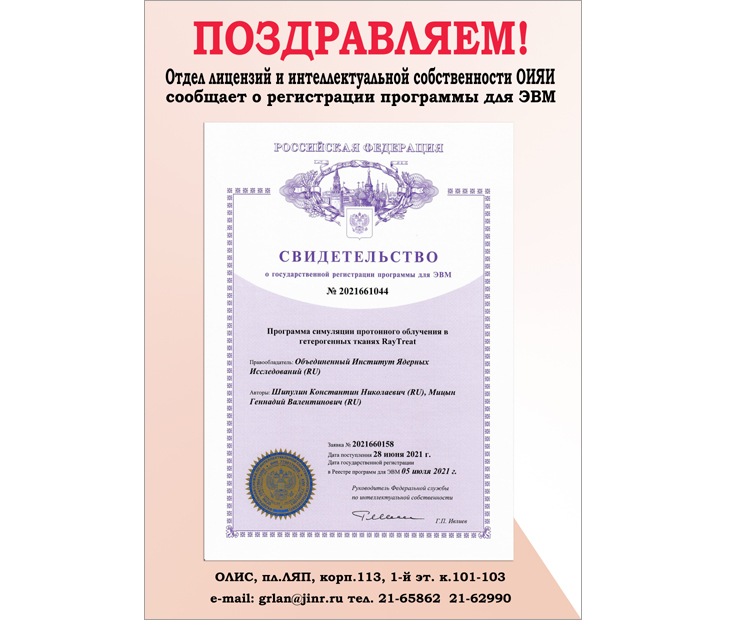New JINR software programs registered
Patents, 24 August 2021
The Licensing and Intellectual Property Department of JINR announces that on 5 July 2021, the Joint Institute for Nuclear Research received two certificates of state registration of software programs:

JINR staff congratulates the authors on registration of the software programmes!
-
“Program for controlling bolus verification device “Bolus Verification”
Author: Konstantin N. Shipulin
The program aims to synchronise with a personal computer (PC) and calibre modules of the bolus verification device (BVD), in particular: the displacement system (DS) and optical sensors (OS). It is also supposed to read data from the BVD to a PC for processing and visualisation. The program allows controlling the accuracy of bolus manufacturing. To display various data, it is possible to choose three measurement modes: milling depth, the height of material left after milling, the difference between calculated and measured values. During the bolus verification procedure, the statistic result processing is underway, the following parameters are calculated: the total number of test points in the bolus, the number of correct points, the number of undefined points, the number of incorrect points, the maximum value of the discrepancy at the point, the minimum value of the discrepancy at the point. The result of the bolus check is a colour scheme displayed on the PC screen that allows geometrically evaluating the accuracy of production depending on the colour of a point. The results are stored in a digital file and archived for each patient. The compiled library XemoDll.dll is download for the program to work with the DS. Computer type: IBM PC-compatible. PC based on Intel, AMD processors. OS: Windows 7 and further versions.
Programming language: Delphi
Programme size: 2,6 MB -
“RayTreat program for simulation of proton irradiation in heterogeneous tissues”
Authors: Konstantin N. Shipulin, Gennady V. Mitsyn
The program aims to calculate dose distribution (DD) in heterogeneous environments, such as human tissues. The algorithm of the planning program (PP) includes the following: loading of initial data of various types of tomographic studies and their visualisation, a graphic editor for drawing and editing the target and critical structures, selection and adjustment of beam parameters necessary for forming conformal dose field, (boluses, figure collimators), DD calculation in heterogeneous environments by the narrow pencil beam (NPB) method, display of the calculated DD, calculation of digital reconstructed radiogram to verify the patient’s position during radiotherapy. The NPB method is used to calculate dose distribution in the RayTreat PP. The method consists in using a Gaussian model to describe the transport of NPB protons. In this method, a wide proton beam limited by the collimator aperture is divided into numerous infinitely thin beams with a step equal to the pixel value of the calculated DD matrix (1 mm thin as a rule). Tracing of each such beam is calculated individually until the full stop of particles. Calculation and indicating dose values from each NPB are carried out according to a two-dimensional Gaussian distribution. This integral is reduced to the generalised Laplace integral earlier calculated and recorded in a digital file for further use in the PP. The result of the calculation using this algorithm is a three-dimensional DD matrix that is 100% normalised at the point of the target isocentre. Based on the values of this matrix, a colour gradient map of the dose field is made that is then displayed on the screen of a personal computer (PC). There is also an opportunity to display the dose field in the form of isolines. For full optimisation of the treatment plan, a dose/volume histogram is calculated using which it is possible to estimate how much of the target or the critical structure will receive a particular dose. This allows quantitatively compare various radiation options. Computer type: IBM PC-compatible. PC based on Intel, AMD processors. OS: Windows 7 and further versions.
Programming language: Delphi
Programme size: 23,7 MB

